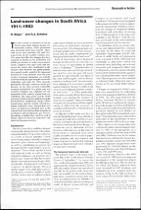JavaScript is disabled for your browser. Some features of this site may not work without it.
- ResearchSpace
- →
- Research Publications/Outputs
- →
- Journal Articles
- →
- View Item
| dc.contributor.author |
Biggs, R

|
en_US |
| dc.contributor.author |
Scholes, RJ

|
en_US |
| dc.date.accessioned | 2007-03-14T14:15:04Z | en_US |
| dc.date.accessioned | 2007-06-07T10:06:44Z | |
| dc.date.available | 2007-03-14T14:15:04Z | en_US |
| dc.date.available | 2007-06-07T10:06:44Z | |
| dc.date.issued | 2002-09 | en_US |
| dc.identifier.citation | Biggs, R and Scholes, RJ. 2002. Land-cover changes in South Africa 1911-1993. South African Journal of Science, vol. 98, 10 September, pp 420-424 | en_US |
| dc.identifier.issn | 0038-2353 | en_US |
| dc.identifier.uri | http://hdl.handle.net/10204/1943 | en_US |
| dc.identifier.uri | http://hdl.handle.net/10204/1943 | |
| dc.description.abstract | The area under cultivation in South Africa more than tripled during the twentieth century, while plantation area increased more than tenfold. These land covers now constitute 12% and 1.5%, respectively, of the country's surface area. This paper describes the changes that have occurred in relation to the production and yields per hectare of major crops (maize, wheat, sorghum and sugar cane) and discusses the factors that contributed to the changes. Both domestic and global population growth partly underlie the increased demand for crop products over the past century. Increased production was initially achieved mainly by expanding the area under cultivation, and, from the 1960s onwards, principally through enhanced yields per hectare. In the latter period, nationally averaged productivity in a given year was related to fertilizer use, irrigation and the proportion of the country experiencing dry conditions. The crops grown and the yields per hectare differed significantly between the predominantly commercial, former white-owned areas and the mainly subsistence, former homeland areas. Independent estimates of historical cultivated area at the national level were derived from estimates of production and productivity per hectare, presenting a method that could be used to obtain improved historical land-cover estimates in data-poor countries. | en_US |
| dc.format.extent | 1539808 bytes | en_US |
| dc.format.mimetype | application/pdf | en_US |
| dc.language.iso | en | en_US |
| dc.publisher | Academy of Science of South Africa | en_US |
| dc.rights | Copyright: 2002 Academy of Science of South Africa | en_US |
| dc.subject | Population growth | en_US |
| dc.subject | Cultivating areas | en_US |
| dc.subject | Food production | en_US |
| dc.subject | Green revolution technologies | en_US |
| dc.title | Land-cover changes in South Africa 1911-1993 | en_US |
| dc.type | Article | en_US |
| dc.identifier.apacitation | Biggs, R., & Scholes, R. (2002). Land-cover changes in South Africa 1911-1993. http://hdl.handle.net/10204/1943 | en_ZA |
| dc.identifier.chicagocitation | Biggs, R, and RJ Scholes "Land-cover changes in South Africa 1911-1993." (2002) http://hdl.handle.net/10204/1943 | en_ZA |
| dc.identifier.vancouvercitation | Biggs R, Scholes R. Land-cover changes in South Africa 1911-1993. 2002; http://hdl.handle.net/10204/1943. | en_ZA |
| dc.identifier.ris | TY - Article AU - Biggs, R AU - Scholes, RJ AB - The area under cultivation in South Africa more than tripled during the twentieth century, while plantation area increased more than tenfold. These land covers now constitute 12% and 1.5%, respectively, of the country's surface area. This paper describes the changes that have occurred in relation to the production and yields per hectare of major crops (maize, wheat, sorghum and sugar cane) and discusses the factors that contributed to the changes. Both domestic and global population growth partly underlie the increased demand for crop products over the past century. Increased production was initially achieved mainly by expanding the area under cultivation, and, from the 1960s onwards, principally through enhanced yields per hectare. In the latter period, nationally averaged productivity in a given year was related to fertilizer use, irrigation and the proportion of the country experiencing dry conditions. The crops grown and the yields per hectare differed significantly between the predominantly commercial, former white-owned areas and the mainly subsistence, former homeland areas. Independent estimates of historical cultivated area at the national level were derived from estimates of production and productivity per hectare, presenting a method that could be used to obtain improved historical land-cover estimates in data-poor countries. DA - 2002-09 DB - ResearchSpace DP - CSIR KW - Population growth KW - Cultivating areas KW - Food production KW - Green revolution technologies LK - https://researchspace.csir.co.za PY - 2002 SM - 0038-2353 T1 - Land-cover changes in South Africa 1911-1993 TI - Land-cover changes in South Africa 1911-1993 UR - http://hdl.handle.net/10204/1943 ER - | en_ZA |






